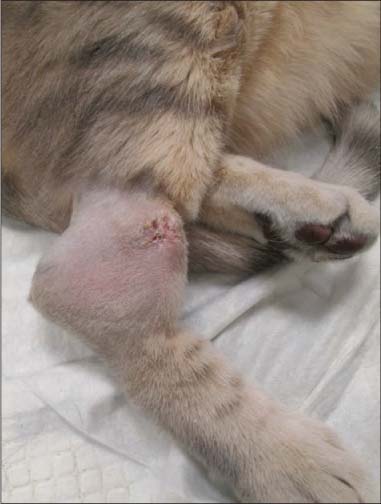Feline Lymphoma
What is lymphoma?
Lymphoma is a cancer of the lymphocytes. Lymphocytes are cells that are involved in the immune system. Lymphocytes travel throughout the body in the blood and lymphatic vessels; therefore, lymphoma is always considered to be a systemic, not localized, disease.
Lymphoma is connected with feline leukemia, a viral infection (see handout “Feline Leukemia Virus Disease Complex”). More cats are now being vaccinated for feline leukemia; therefore, lymphoma is becoming less common. It is still a frequently-seen cancer, accounting for approximately 30% of new feline cancer diagnoses. Common sites of lymphoma in cats include:
- Intestinal lymphoma.This term describes lymphoma that affects the gastrointestinal tract. This is, by far, the most common type of lymphoma in cats, accounting for 50-70% of feline lymphoma cases. It is most common in senior cats, with the average age at diagnosis ranging from 9-13 years old.
- Mediastinal lymphoma.In this form of lymphoma, lymphoid organs in the chest (such as the lymph nodes or the thymus) are affected. Mediastinal lymphoma is often seen in young cats, with an average age of onset of 5 years old. This type of lymphoma is strongly associated with feline leukemia virus; 80% of affected cats test positive for feline leukemia.
- Renal lymphoma.Lymphoma in the kidney can lead to signs of kidney failure, as functional kidney cells are replaced by cancer cells. This type of lymphoma is also associated with feline leukemia, with 50% of affected cats testing positive for feline leukemia.
What are the clinical signs of lymphoma?
Feline lymphoma most commonly affects the intestines. Therefore, clinical signs of lymphoma are often similar to other intestinal diseases. Affected cats often develop weight loss, vomiting, and diarrhea. Appetite varies; some cats have a decrease in appetite, some have an increased appetite, while others have no change in appetite.
Mediastinal lymphoma occurs within the chest, and therefore is often associated with respiratory difficulties. Fluid often begins to accumulate around the tumor, making it more difficult for an affected cat to fully inflate her lungs.
In cats with renal lymphoma, signs associated with kidney failure may be seen. These signs often include decreased appetite, weight loss, increased thirst, and vomiting. These changes are all associated with a buildup of toxins in the bloodstream, which the kidneys are unable to effectively filter out when affected by lymphoma.
How is lymphoma diagnosed?
Diagnosing lymphoma requires finding cancerous cells on microscopic examination. Your veterinarian also may perform baseline screening bloodwork before testing for lymphoma, in order to assess your cat’s overall health and rule out other causes of your cat’s clinical signs.
In some cases, feline lymphoma can be diagnosed with a fine needle aspirate. In this test, a veterinarian will insert a needle into an area of concern (an enlarged lymph node, enlarged kidney, thickened region of intestine, or fluid present within the chest) and remove a small number of cells. These cells will then be examined under a microscope, looking for cancer cells that indicate lymphoma. Although it is not always possible to obtain a high-quality diagnostic sample via aspirate, many veterinarians start with this test because it carries minimal risks, side effects, and costs compared to surgical biopsy.
If a fine needle aspirate is inconclusive, or is impractical due to the location of the lesion, your veterinarian may instead perform a surgical biopsy. This involves the removal of a piece of tissue from the lesion. In cases of suspected gastrointestinal lymphoma, this sample may be obtained surgically (by opening your cat’s abdomen and surgically removing a piece of thickened intestine) or endoscopically (by threading an endoscope down your cat’s intestine and using a camera and specialized tools to remove a piece of the interior surface of the intestine). Regardless of collection technique, this sample will be processed and examined under a microscope to assess for lymphoma.
If lymphoma is diagnosed via biopsy, the pathologist can also determine whether your cat possesses high-grade or low-grade lymphoma. This determination is based on how rapidly the cancer cells appear to be dividing and how malignant the cells appear to be; high-grade lymphoma is fast-growing and more malignant. Low-grade lymphoma, in cats, is more likely to respond to chemotherapy and chemotherapy often results in longer periods of remission.
If your cat is diagnosed with lymphoma, your veterinarian may perform additional testing, such as immunohistochemistry. This testing can help further characterize the lymphoma and develop a treatment plan.
How is lymphoma treated?
Lymphoma is usually treated with chemotherapy. Low-grade lymphoma is treated with prednisone (a steroid) and chlorambucil (an oral chemotherapy agent). High-grade lymphoma is treated using one of a number of injectable chemotherapy protocols.Cats tolerate chemotherapy much better than humans; they rarely lose their hair or appear sick. The most common side effects include vomiting, diarrhea, and decreased appetite. However, even these effects are seen in only about 10% of patients.
Surgery and/or radiation may be appropriate for lymphoma that is confined to one area, such as nasal tumors or abdominal masses, but this is uncommon. Most cases cannot be successfully treated with surgery or radiation and will require chemotherapy.
If chemotherapy is not an option, due to a cat’s illness or owner finances, prednisone can be used for palliative, or hospice, care. Although prednisone does not treat lymphoma, it can provide a temporary reduction in clinical signs and buy the pet some time.

What is the prognosis for lymphoma?
The prognosis for lymphoma depends on the location of the lymphoma, how sick the cat is at the start of treatment, the cat’s feline leukemia status, and how quickly the disease is diagnosed and treated.
Most cases of gastrointestinal lymphoma are low-grade lymphoma. With treatment, approximately 70% of cats with low-grade lymphoma will go into remission. Lymphoma is never truly ‘cured,’ but remission is a term that is used to describe the temporary resolution of all signs of lymphoma. The average remission for low-grade lymphoma is 2-3 years, meaning 2-3 years without any signs of disease.
High-grade gastrointestinal lymphoma, however, does not respond as well to treatment. Only 25-50% of cats with high-grade lymphoma achieve remission with treatment. Typically, this period of remission lasts only 2-9 months, and then cats become ill again.
Mediastinal lymphoma in cats with feline leukemia carries a poor prognosis, with an average survival time of 3 months. In cats without feline leukemia, mediastinal lymphoma often shows at least a partial response to chemotherapy. These cats show an average survival time of 9-12 months, with the initial response to treatment often giving an indication of survival time.
Renal lymphoma, unfortunately, carries a very poor prognosis. Average survival with this type of lymphoma is only 3-6 months, though there are isolated reports of cats surviving far longer. Renal lymphoma has a tendency to spread to the brain and central nervous system; this occurs in approximately 40% of renal lymphoma cases and worsens the prognosis for this disease.
How can I reduce the likelihood of my cat developing lymphoma?
Lymphoma cannot be prevented, but the likelihood of a cat developing lymphoma can be decreased by preventing feline leukemia virus infection. All cats who go outdoors, or whose owners take in strays of unknown feline leukemia status, should be vaccinated against this virus to prevent feline leukemia infection.



